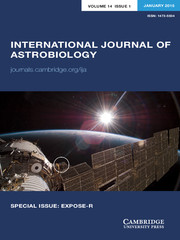Crossref Citations
This article has been cited by the following publications. This list is generated based on data provided by
Crossref.
Wickramasinghe, Chandra
2010.
The astrobiological case for our cosmic ancestry.
International Journal of Astrobiology,
Vol. 9,
Issue. 2,
p.
119.
Wickramasinghe, Chandra
2011.
Astronomy and Civilization in the New Enlightenment.
p.
211.
Wickramasinghe, Chandra
2011.
Bacterial morphologies supporting cometary panspermia: a reappraisal.
International Journal of Astrobiology,
Vol. 10,
Issue. 1,
p.
25.
Wickramasinghe, Chandra
2012.
Genesis - In The Beginning.
Vol. 22,
Issue. ,
p.
621.
WICKRAMASINGHE, N. C.
WALLIS, J.
and
WALLIS, D. H.
2013.
PANSPERMIA: EVIDENCE FROM ASTRONOMY TO METEORITES.
Modern Physics Letters A,
Vol. 28,
Issue. 14,
p.
1330009.
Davankov, Vadim A.
2016.
Homochirality of Organic Matter – Objective Law or Curious Incident?.
Israel Journal of Chemistry,
Vol. 56,
Issue. 11-12,
p.
1036.
Adam, Z. R.
Zubarev, D.
Aono, M.
and
Cleaves, H. James
2017.
Subsumed complexity: abiogenesis as a by-product of complex energy transduction.
Philosophical Transactions of the Royal Society A: Mathematical, Physical and Engineering Sciences,
Vol. 375,
Issue. 2109,
p.
20160348.
Steele, Edward J.
Al-Mufti, Shirwan
Augustyn, Kenneth A.
Chandrajith, Rohana
Coghlan, John P.
Coulson, S.G.
Ghosh, Sudipto
Gillman, Mark
Gorczynski, Reginald M.
Klyce, Brig
Louis, Godfrey
Mahanama, Kithsiri
Oliver, Keith R.
Padron, Julio
Qu, Jiangwen
Schuster, John A.
Smith, W.E.
Snyder, Duane P.
Steele, Julian A.
Stewart, Brent J.
Temple, Robert
Tokoro, Gensuke
Tout, Christopher A.
Unzicker, Alexander
Wainwright, Milton
Wallis, Jamie
Wallis, Daryl H.
Wallis, Max K.
Wetherall, John
Wickramasinghe, D.T.
Wickramasinghe, J.T.
Wickramasinghe, N. Chandra
and
Liu, Yongsheng
2018.
Cause of Cambrian Explosion - Terrestrial or Cosmic?.
Progress in Biophysics and Molecular Biology,
Vol. 136,
Issue. ,
p.
3.
Perryman, Michael
2018.
The Exoplanet Handbook.
Pérez-Villa, Andrea
Pietrucci, Fabio
and
Saitta, A. Marco
2020.
Prebiotic chemistry and origins of life research with atomistic computer simulations.
Physics of Life Reviews,
Vol. 34-35,
Issue. ,
p.
105.
Rao, Y. V. Subba
2021.
NEW THEORY OF EVOLUTION FROM GENETIC COMPLEXITY OF DIVERSE PERSPECTIVES.
International Journal of Research -GRANTHAALAYAH,
Vol. 9,
Issue. 10,
p.
291.
Devergne, Timothée
Magrino, Théo
Pietrucci, Fabio
and
Saitta, A. Marco
2022.
Combining Machine Learning Approaches and Accurate Ab Initio Enhanced Sampling Methods for Prebiotic Chemical Reactions in Solution.
Journal of Chemical Theory and Computation,
Vol. 18,
Issue. 9,
p.
5410.

